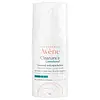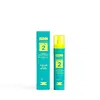What's inside
What's inside
 Key Ingredients
Key Ingredients

 Benefits
Benefits

 Concerns
Concerns

 Ingredients Side-by-side
Ingredients Side-by-side

Water
Skin ConditioningDimethicone
EmollientNiacinamide
SmoothingBetaine
HumectantLauryl PEG/PPG-18/18 Methicone
Skin ConditioningPropanediol
SolventSilica
AbrasiveDibutyl Adipate
EmollientAlcohol Denat.
AntimicrobialZinc PCA
Humectant1,2-Hexanediol
Skin ConditioningPentylene Glycol
Skin ConditioningCaprylyl Glycol
Emollient4-T-Butylcyclohexanol
MaskingSodium Acrylates Crosspolymer-2
AbsorbentPolyacrylate Crosspolymer-6
Emulsion StabilisingXylitol
HumectantCaprylic Acid
CleansingTocopheryl Acetate
AntioxidantSphingomonas Ferment Extract
Skin ConditioningCaprylic/Capric Triglyceride
MaskingGlycerin
HumectantHydroxyacetophenone
AntioxidantPentaerythrityl Tetra-Di-T-Butyl Hydroxyhydrocinnamate
AntioxidantParfum
MaskingMaltodextrin
AbsorbentBixa Orellana Seed Extract
MaskingHydrolyzed Opuntia Ficus-Indica Flower Extract
AbrasiveDisodium EDTA
Tocopherol
AntioxidantRetinal
Skin ConditioningSodium Hydroxide
BufferingPhospholipids
Skin ConditioningT-Butyl Alcohol
PerfumingCitral
PerfumingAscorbic Acid
AntioxidantWater, Dimethicone, Niacinamide, Betaine, Lauryl PEG/PPG-18/18 Methicone, Propanediol, Silica, Dibutyl Adipate, Alcohol Denat., Zinc PCA, 1,2-Hexanediol, Pentylene Glycol, Caprylyl Glycol, 4-T-Butylcyclohexanol, Sodium Acrylates Crosspolymer-2, Polyacrylate Crosspolymer-6, Xylitol, Caprylic Acid, Tocopheryl Acetate, Sphingomonas Ferment Extract, Caprylic/Capric Triglyceride, Glycerin, Hydroxyacetophenone, Pentaerythrityl Tetra-Di-T-Butyl Hydroxyhydrocinnamate, Parfum, Maltodextrin, Bixa Orellana Seed Extract, Hydrolyzed Opuntia Ficus-Indica Flower Extract, Disodium EDTA, Tocopherol, Retinal, Sodium Hydroxide, Phospholipids, T-Butyl Alcohol, Citral, Ascorbic Acid
 Reviews
Reviews

Alternatives
Ingredients Explained
These ingredients are found in both products.
Ingredients higher up in an ingredient list are typically present in a larger amount.
Glycerin is already naturally found in your skin. It helps moisturize and protect your skin.
A study from 2016 found glycerin to be more effective as a humectant than AHAs and hyaluronic acid.
As a humectant, it helps the skin stay hydrated by pulling moisture to your skin. The low molecular weight of glycerin allows it to pull moisture into the deeper layers of your skin.
Hydrated skin improves your skin barrier; Your skin barrier helps protect against irritants and bacteria.
Glycerin has also been found to have antimicrobial and antiviral properties. Due to these properties, glycerin is often used in wound and burn treatments.
In cosmetics, glycerin is usually derived from plants such as soybean or palm. However, it can also be sourced from animals, such as tallow or animal fat.
This ingredient is organic, colorless, odorless, and non-toxic.
Glycerin is the name for this ingredient in American English. British English uses Glycerol/Glycerine.
Learn more about GlycerinSilica, also known as silicon dioxide, is a naturally occurring mineral. It is used as a fine, spherical, and porous powder in cosmetics.
Though it has exfoliant properties, the function of silica varies depending on the product.
The unique structure of silica enhances the spreadability and adds smoothness, making it a great texture enhancer.
It is also used as an active carrier, emulsifier, and mattifier due to its ability to absorb excess oil.
In some products, tiny microneedles called spicules are made from silica or hydrolyzed sponge. When you rub them in, they lightly polish away dead skin layers and enhance the penetration of active ingredients.
Learn more about SilicaWater. It's the most common cosmetic ingredient of all. You'll usually see it at the top of ingredient lists, meaning that it makes up the largest part of the product.
So why is it so popular? Water most often acts as a solvent - this means that it helps dissolve other ingredients into the formulation.
You'll also recognize water as that liquid we all need to stay alive. If you see this, drink a glass of water. Stay hydrated!
Learn more about Water